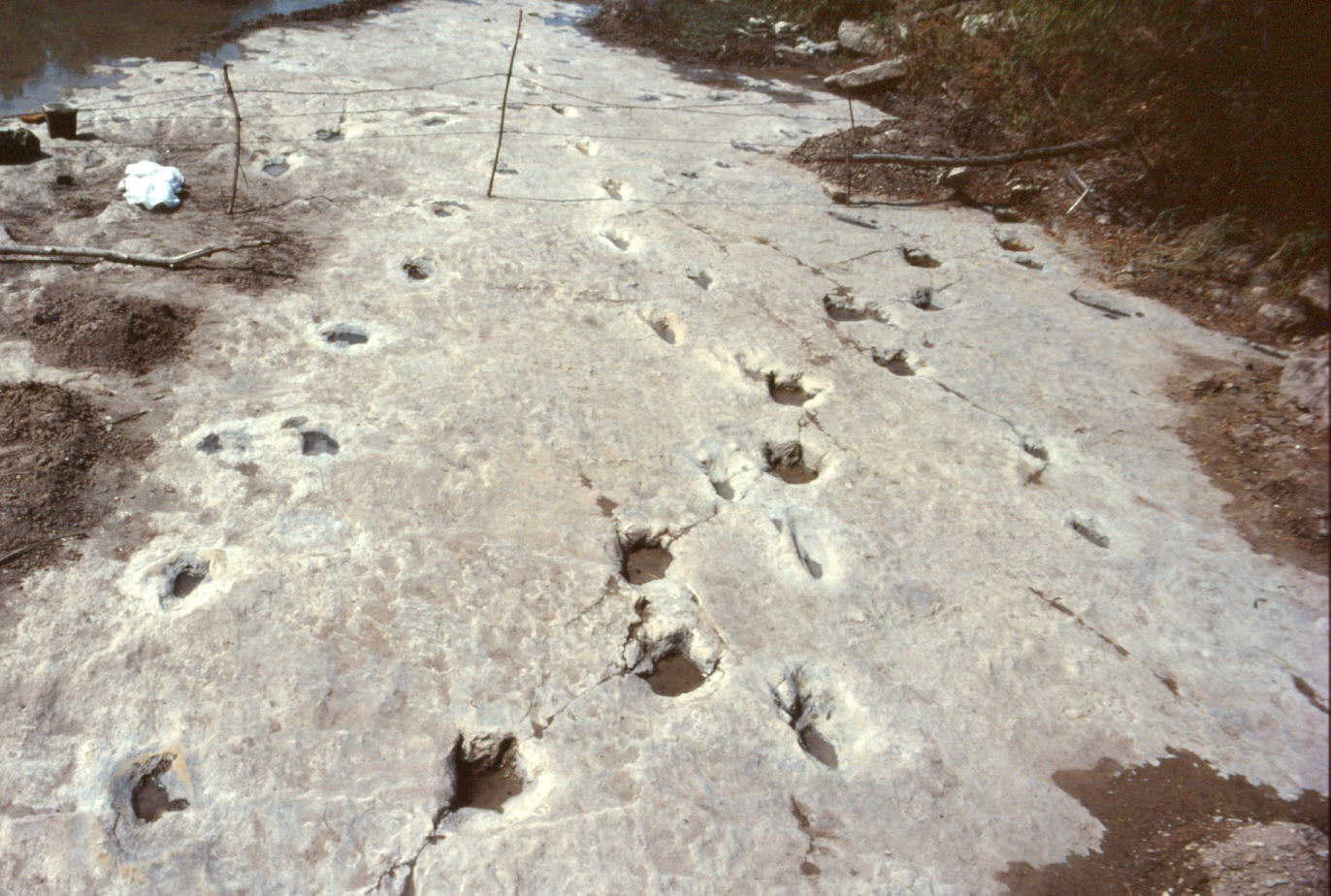
Part of Kuban's Paluxy web site
Originally published in Origins Research, Vol. 9, No. 1, Spring/Summer 1986, pp. 2-10.
Reports of "giant man tracks" began circulating among Glen Rose residents in the early part of this century. In 1950 Clifford L. Burdick wrote an article supporting the "man track" claims, and showing a photograph of two large, unnaturally-shaped footprints on loose rock slabs, supposedly representing genuine "giant tracks."[1] Burdick's claims were subsequently featured in the widely-read book The Genesis Flood.[2] These claims came to the attention of Stanley E. Taylor (since deceased), who organized a team of creationists in 1968 to find and film the "giant man tracks" in the Paluxy Riverbed as part of a documentary on the creation/evolution controversy.

|
| Figure0. A. High overhead view of the main section of the Taylor Site facing southwest (1984). The Taylor (IIS) Trail --the most renown of the alleged human trackways --proceeds from bottom-center to upper left. The Turnage (IIN) Trail, another trackway once called human, is in the lower right. The "Giant Run" (GR) trail proceeds toward the center-right. Other trails are visible in background (compare map, Fig. 14). |
In 1968 Taylor and his crew found numerous oblong marks which they thought to be human tracks. Seeking more evidence, they returned in 1969 and 1970 to excavate an area now known as the Taylor Site, located a few hundred yards west of Dinosaur Valley State Park. On this site were found many elongated impressions which Taylor considered to be definite human tracks, as well as other tracks acknowledged to be dinosaurian. In 1973 Taylor released the film Footprints in Stone[3] which prominently featured the Taylor Site tracks. Subsequently, the Taylor Site "man tracks" were cited in numerous books, articles, tapes, and were hailed by many creationists as one of the most dramatic evidences against the theory of evolution.
The Taylor Site contains a long trail of deeply impressed dinosaur tracks, and several shallower trails, four of which have been claimed by many creationists to be human: the Giant Run Trail, the Turnage Trail, the Taylor Trail, and the Ryals Trail (which includes a large hole reported to be the spot from which a human track was removed many years ago). Many of these alleged "man tracks" were fairly shallow and more or less oblong in shape, and did not match the shape of any dinosaur tracks known to the Taylor crew. Some of the these tracks did vaguely resemble human footprints, however, many of the tracks also showed problematic (non-human) features (discussed further below). This site has received more acclaim than other "man track" sites for the following reasons: 1) The elongated tracks on this site are numerous and occur in clear right-left sequences; 2) At least some of these tracks were excavated from under previously undisturbed strata, precluding the possibility that they are carvings or erosion marks; 3) Many of them show "mud push-ups" and other features confirming that they are real tracks and not erosion marks or carvings; 4) Several of the "man tracks" were reported to show clear human toe marks when first uncovered[4] (although no published photographs have ever shown this); and 5) Three of the alleged human trails (Taylor, Turnage, and Giant Run) intersect the trail of deep and distinct dinosaur tracks, providing clear evidence that the elongated tracks and the deep dinosaur tracks were made at approximately the same time.
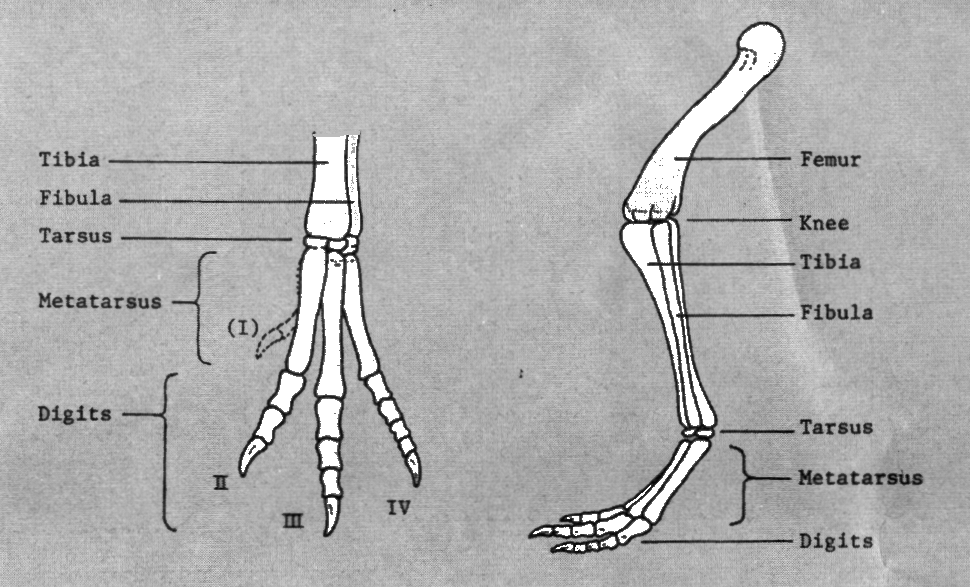 |
| Figure 1A. Generalized leg of a bipedal dinosaur. |
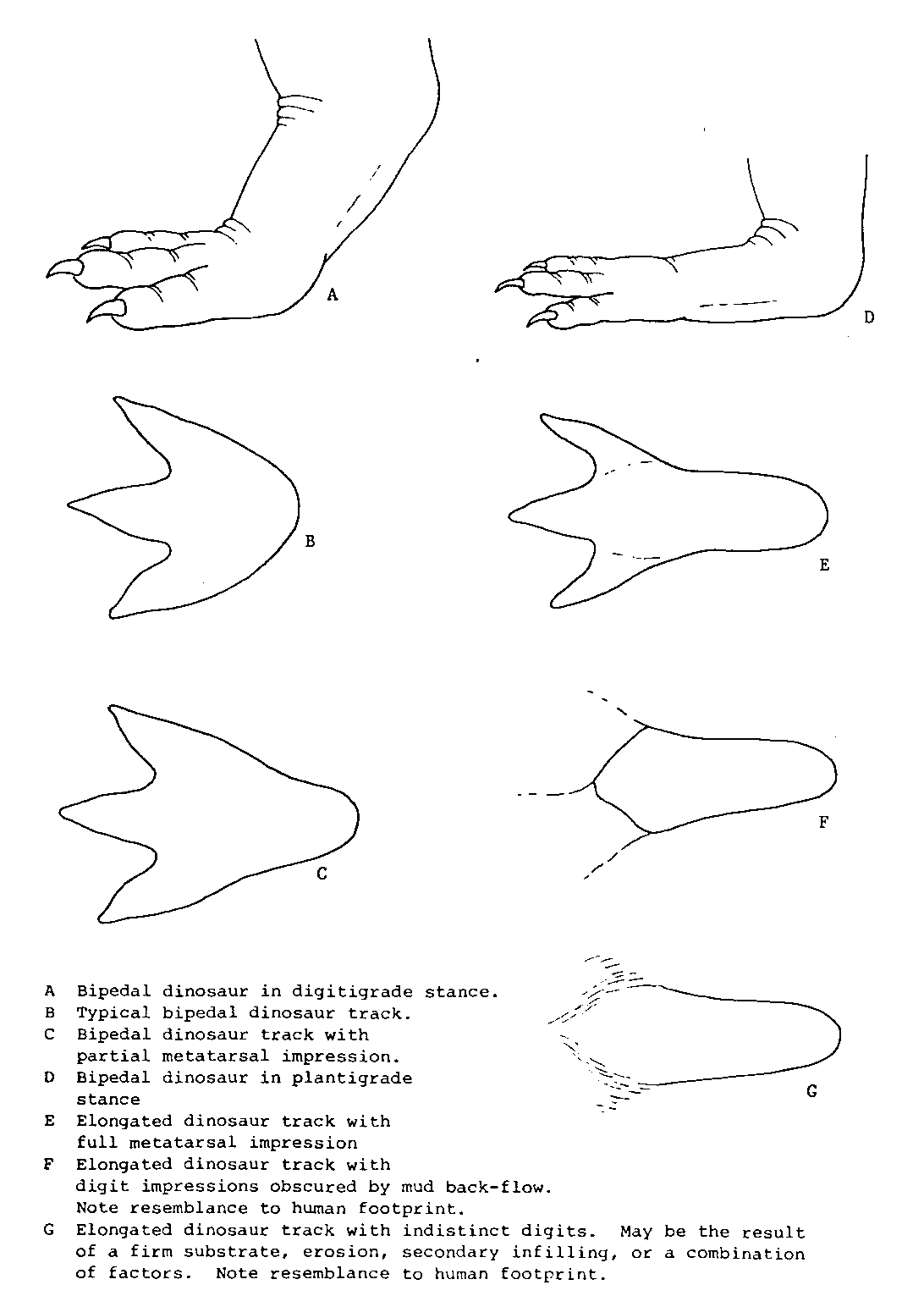
|
| Figure 1B. Variations of bipedal dinosaur tracks. |
Even before the film Footprints in Stone was released, the Taylor Site was studied by a another team of creationist scientists from Loma Linda University.[5] In contrast to the "man track" claims of the Taylor crew, the Loma Linda team concluded in their published report that several of the tracks in the Taylor Trail showed indications of dinosaurian digits, and that the tracks were probably the eroded remains of three-toed dinosaur tracks, although they did not adequately explain how the tracks acquired their very elongated shape. Other creationists, such as Dr. Ernest Booth of Outdoor Pictures, Inc., and Wilbert Rusch, president of the Creation Research Society, also visited the site soon after the tracks site was first exposed, and expressed skepticism about the "man track" claims.[6] Nevertheless, the impact of Taylor's film and other creationist works which promoted the "man track" claims led to the wide acclaim of this site among creationists, especially during the 1970's. Most evolutionists familiar with these claims apparently did not feel they were worth careful investigation, and typically dismissed the "man tracks" with one or more generalizations. Some claimed all the "man tracks" were carvings or erosion marks. Others attributed them to middle digit impressions of bipedal dinosaurs, or to mud-collapsed specimens of typical tridactyl (three-toed) dinosaur tracks. Although some of these explanations did pertain to alleged human tracks on other sites, none of them adequately explained all the features of the Taylor Site "man tracks."
During the 1970's, several other creationist teams re-exposed the site, but little new information was contributed, and most of the members of these teams reaffirmed that the elongated tracks on the Taylor Site were human or human-like.[7] John Morris, now at the Institute for Creation research near San Diego, was involved in some of the Paluxy work during the late 1970's. In 1980 Morris published a book supporting many of the "man track" claims, and arguing that the Taylor Site "man tracks" were clearly human.[8]
I began my own field study of the Taylor Site in 1980, as part of an on-going and intensive study of all Paluxy sites alleged to contain human tracks. Although working largely independently, I have cooperated in my research with a number of other investigators, including Dr. Ronnie Hastings of Waxahachie, Texas, with whom I have worked closely during the past two years.
After thoroughly exposing and cleaning the Taylor Site during a drought in the summer of 1980, my associate, Tim Bartholomew, and I took many measurements, photographs, and rubber casts of the alleged "man tracks."[9] We noted that many of the Taylor Site "man tracks" did have a general oblong shape, rounded heel, and mud push-ups around the back and sides of the track, but differed in significant ways from what would be expected from genuine human tracks. Most splayed into a wide "V" at the anterior, and some showed long, shallow groves at the anterior in positions that were incompatible with a human foot. The front of the tracks thus appeared to indicate a tridactyl (dinosaurian) foot, but the long posterior extension was puzzling, and seemed inconsistent with the Loma Linda team's suggestion that these tracks merely represented eroded specimens of typical tridactyl dinosaur tracks. I hypothesized, based on the observed features of the tracks, that a dinosaur may have existed which, rather than walking in the normal digitigrade (toe-walking) fashion of most bipedal dinosaurs, may have walked in a plantigrade or quasi-plantigrade fashion, placing weight on its tarso-metatarsus (heel and sole), thereby creating elongated impressions. This seemed to account for all the features on the tracks--with the lack of clear digit impressions being attributable to any of several possible factors, such as erosion of the digit impressions, or the indistinct initial impression of the digits (due to a firm substrate, which would also account for the shallowness of the elongated tracks).
That dinosaurs were capable of making elongated impressions by impressing their metatarsi into the sediment was confirmed by my documentation in 1982 and 1983 of another Paluxy site, bordering the Alfred West property, about a mile south of Dinosaur Valley State Park. On the West Site are many typical tridactyl tracks, and several trails composed primarily of elongated dinosaur tracks. Some of the trails with elongated tracks also contain some non-elongated and partially elongated dinosaur tracks, apparently indicating that the dinosaur would sometimes alter the extent to which it impressed its metatarsi into the sediment. The clarity of the individual tracks also varied greatly, especially in the region of the digits (Figure 6). Many of the elongated tracks showed three distinct dinosaurian digits, as well as a posterior extension with rounded "heel." In other tracks in these very same trackways, the digit impressions were indistinct or absent altogether (in most cases this appeared to be the result of mud back-flow and/or erosion), leaving oblong depressions which superficially resembled human footprints. This site clearly demonstrated that dinosaurs were capable of making elongated, even "man-like" impressions. Many of the elongated dinosaur tracks on the West Site closely resembled the size and shape of the elongated tracks on the Taylor Site, supporting the theory that the Taylor Site tracks also represented a metatarsal impression phenomenon. Alfred West had known about the elongated dinosaur tracks bordering his property for years, and had suspected that they related to many of the "giant man track" claims, had been made.
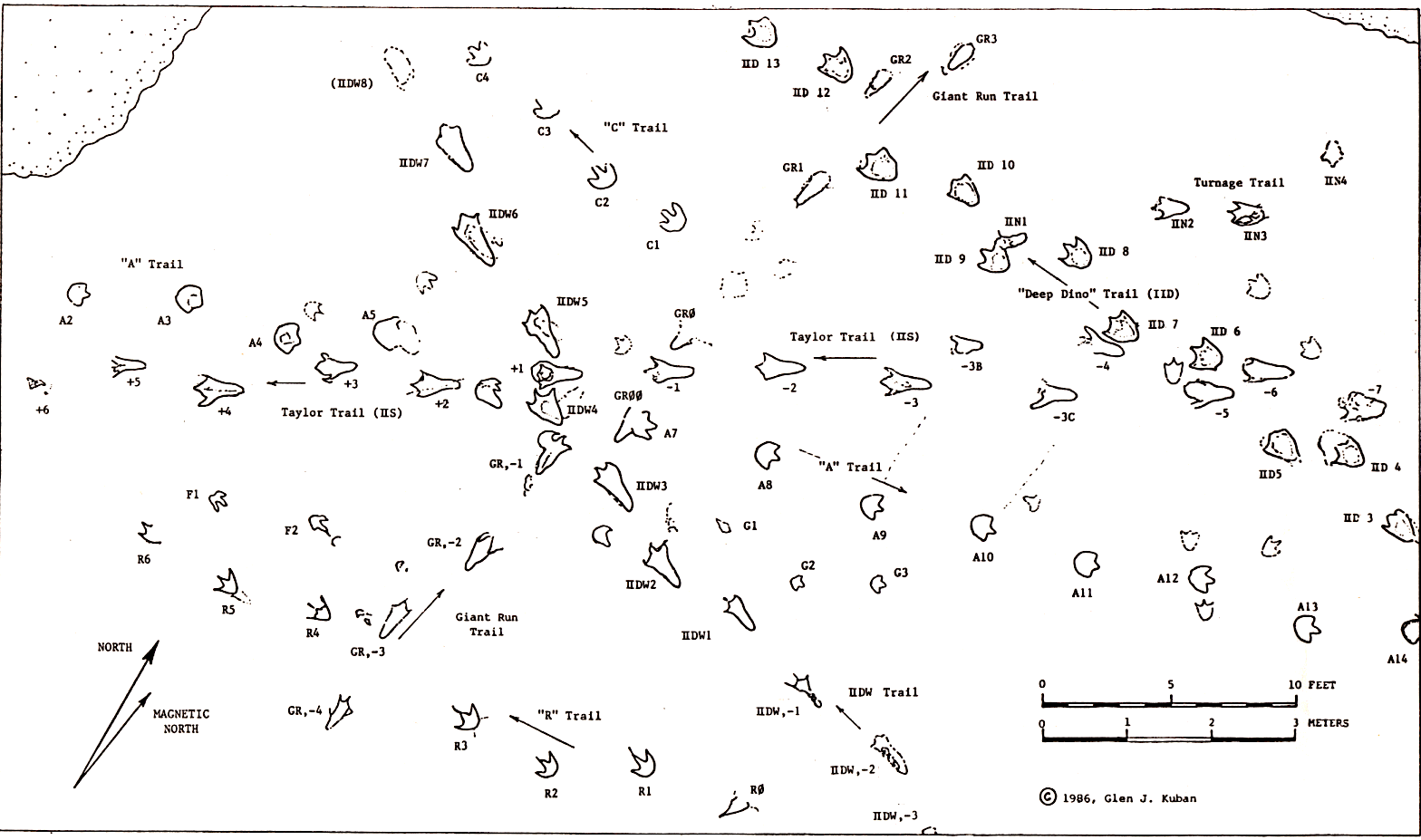
| |
| Figure 2. The Taylor Site (main section), based on field work between 1980 and 1985. Track outlines indicate boundaries of color distinctions and/or relief differences from surrounding substrate. The north bank of the Paluxy River occurs just past the top of the map. Additional tracks occur outside the map borders, including the Ryals Trail (Fig. 3). |
In addition to the numerous trails of elongated dinosaur tracks on the West and Taylor Sites, I have found these metatarsal or "metapodial" type dinosaur tracks on other Paluxy sites as well. The digit impressions of these tracks can be obscured by any of several phenomena: erosion, mud back-flow, secondary sediment infilling, lack of initial digit impressions (due to a firm substrate), or any combination of these factors. Even in distinct specimens of elongated dinosaur tracks, the digit region is typically the shallowest part of the track, making them especially prone to being obscured by erosion or mud back-flow. Those tracks which show little or no indication of the digits appear as indistinct oblong depressions, somewhat wider at the front than the back, and thus more or less resemble giant human footprints (see Figure 1). When the digits are well preserved, these metapodial tracks typically range from 21 to 27 inches in length; when the digits are obscured they range between 15 and 20 inches in length (not surprisingly, the same size range as the reported "giant man tracks"). Although these metapodial dinosaur tracks in Glen Rose have been overlooked or misidentified by most researchers for decades, they are fairly common in the Paluxy area, and in my opinion are probably the source of the initial rumors of "giant man tracks" in the Paluxy many years ago.
 |
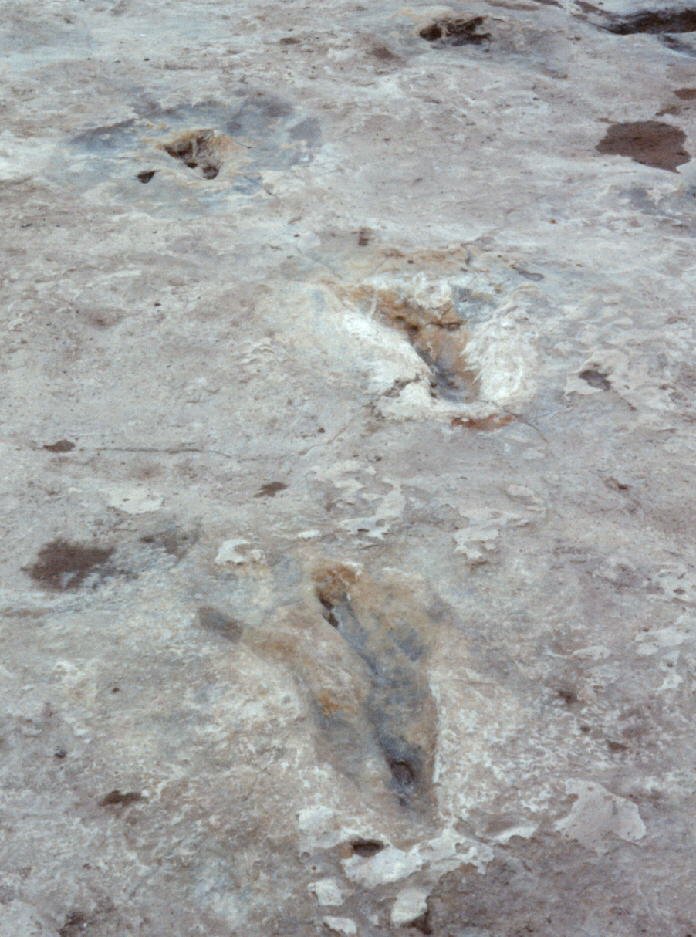 |
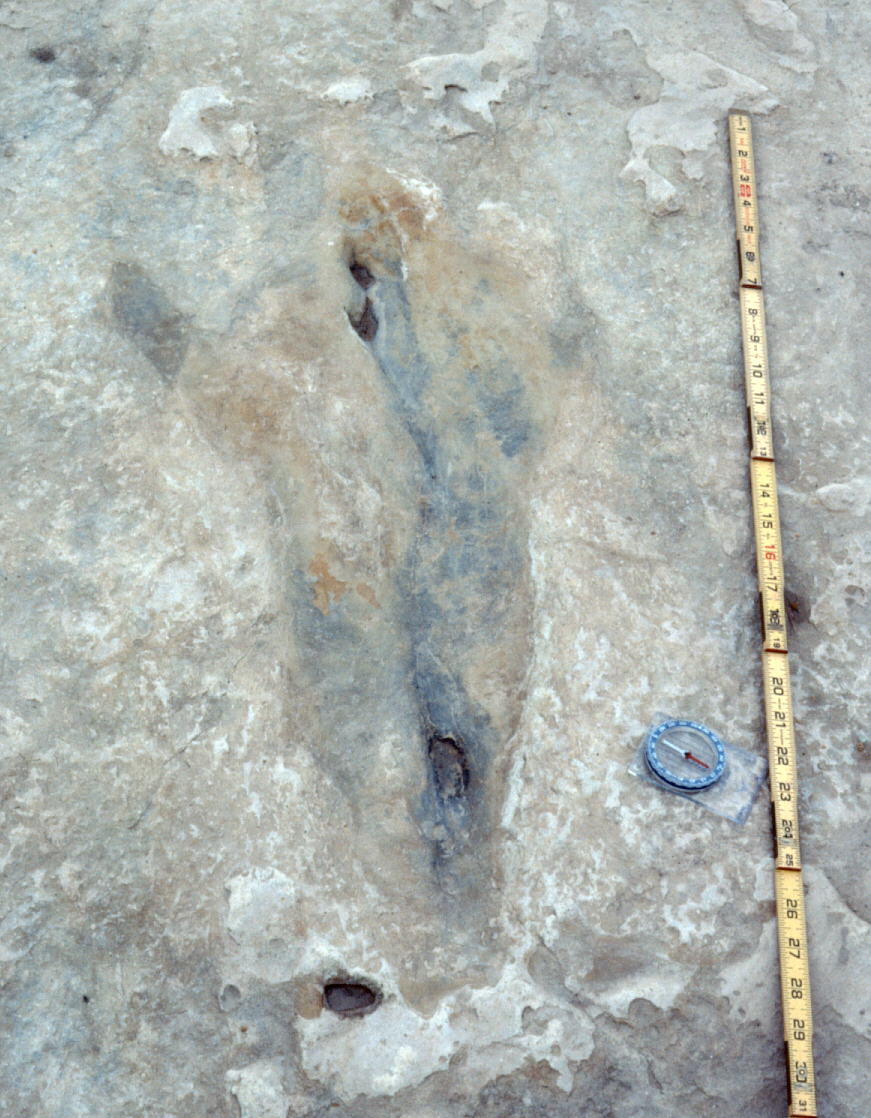 |
| Figure 2A. Taylor Trail, western end, 1984. Track IIS+2 at bottom. Note tridactyl patterns at front of the tracks. | Figure 2B. Taylor Trail, 1984. Track IIS+4 at bottom. | Figure 2C. Taylor Trail track IIS+4, 1984, showing blue-grey and rust-brown coloration corresponding to infilled sediment. The coloration features on this track were visible but less prominent, in the film Footprints in Stone. |
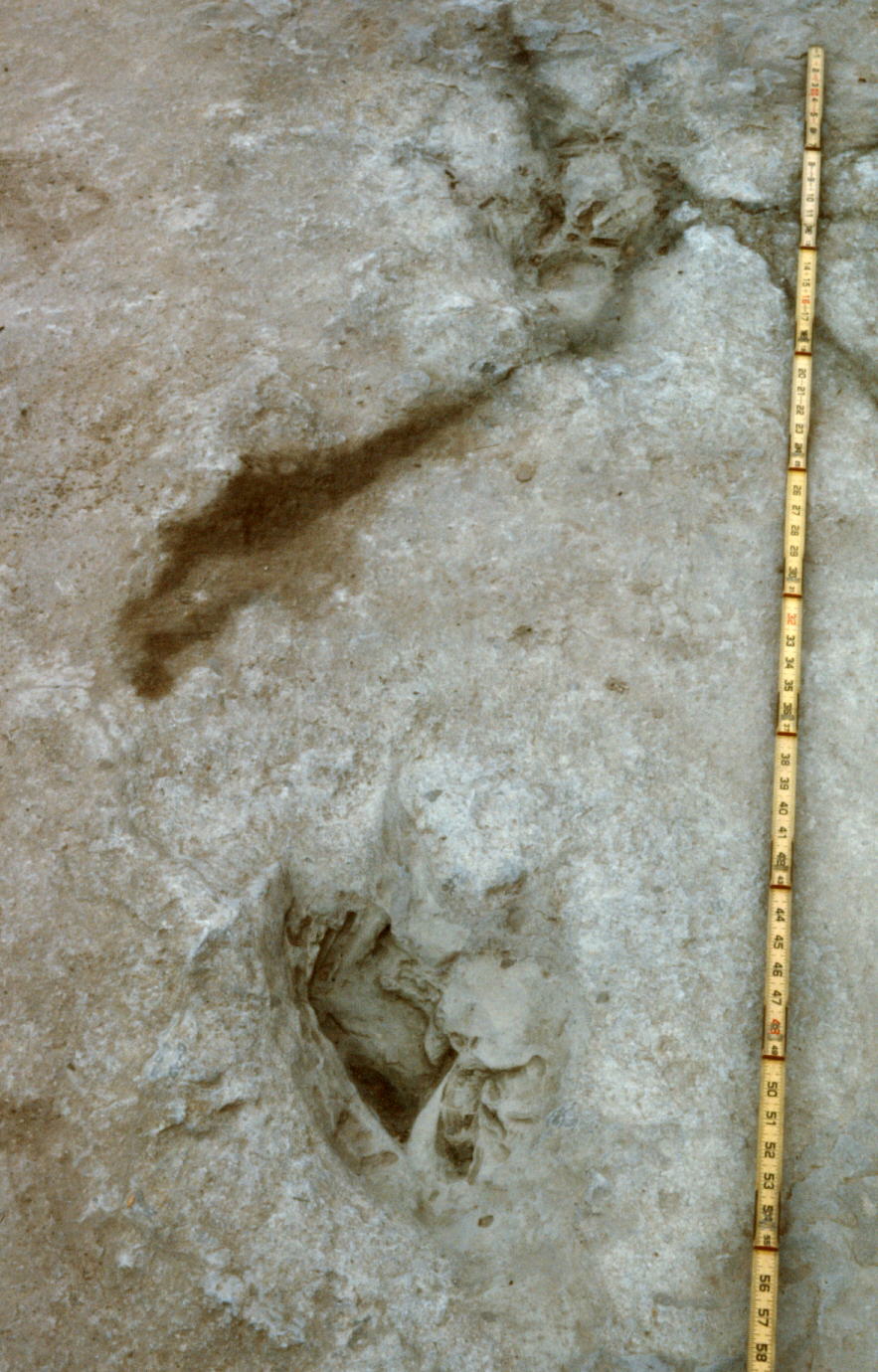 |
| Figure 2d. Turnage Trail, 1984. Track IIN1 at bottom. Note blue-grey color and texture contrast of infilling material indicating a tridactyl digit pattern. |
In September of 1984 Hastings and I extended the documentation of the Taylor Site, finding some new and startling evidence to confirm that the Taylor Site "man tracks" were in fact elongated dinosaur tracks. Coloration patterns that were previously noticed on some of the tracks had become more distinct, and were visible on most of the other tracks as well. These color distinctions ranged from blue-grey to rust, (in contrast with the ivory to tan color of the surrounding limestone). On the elongated tracks, the colorations followed the elongated, posterior portion of the tracks, but also extended into the shallower digit region. They often corresponded to the shallow tridactyl groves at the front of many of the tracks, and clearly defined the shape of the dinosaurian digits, but also occurred even in places where there was not a significant depression in the rock surface. These features suggested that the lack of distinct digit indentations on many of these tracks was not due to erosion or mud back- flow (as on the West Site), but to the infilling of the original impressions with secondary sediment that later hardened into the impressions. Now that the infilled material is becoming more visible by virtue of the color distinctions, the shapes of the original impressions are easily seen, and confirm that all of the tracks on the Taylor Site are dinosaur tracks. That these elongated tracks and some of the smaller non-elongated tridactyl trails on the site are shallower than the deep dinosaur trail (IID) may be due to combination of factors, including the infilling phenomena, differences in the sizes and weights of the individual dinosaurs, and possible differences in the consistency of the sediment at the times the individual dinosaurs walked across the site.
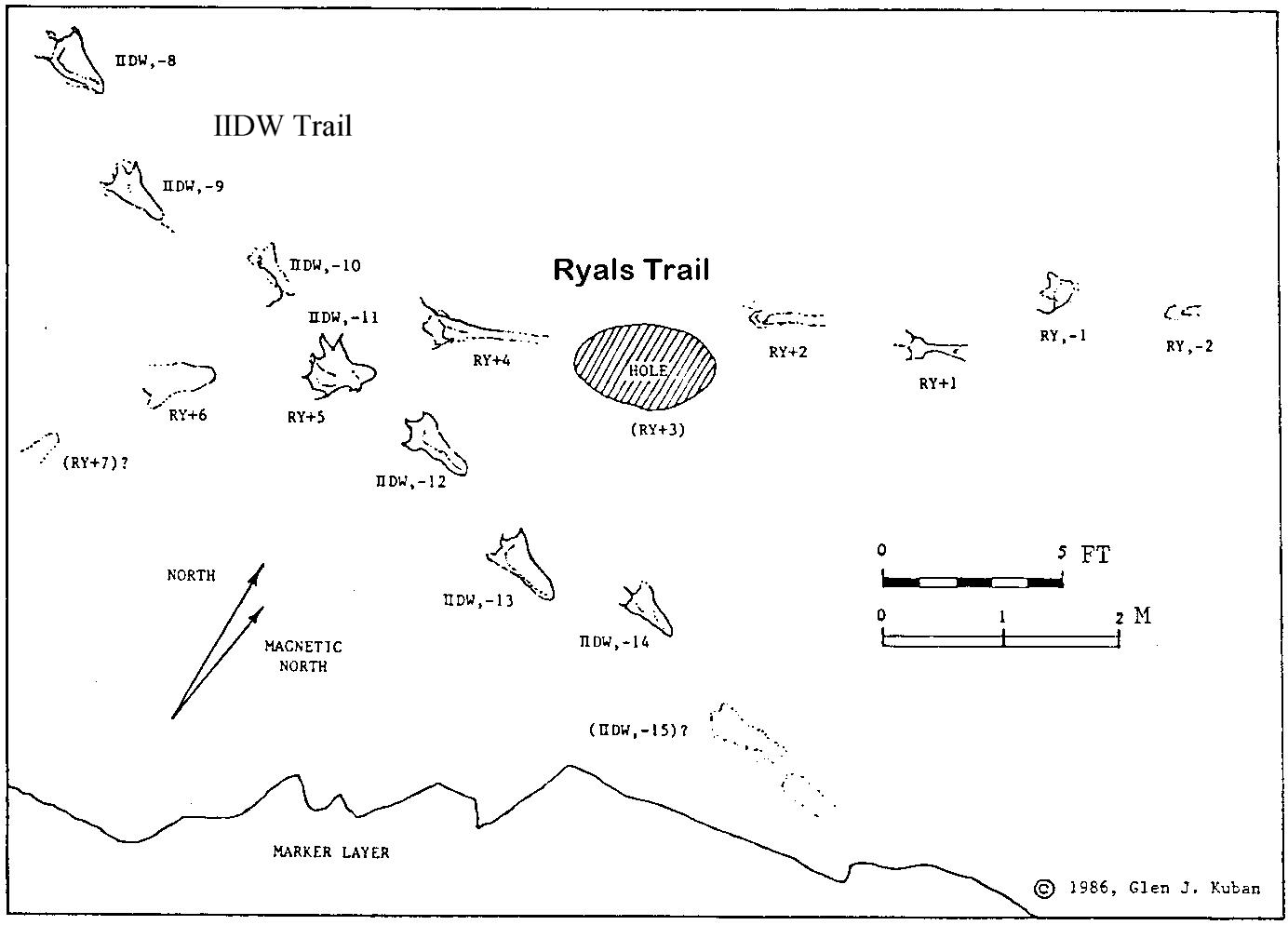
| Figure 3. Ryals Trail section of the Taylor Site. This section occurs just east of the area shown in Figure 14. Intersecting the Ryals (RY) Trail is the IIDW Trail, a long sequence of metatarsal tracks that traverses the entire riverbed and intersects the Taylor Trail near the north bank. The oval hole reportedly represents a track removed by Jim Ryals during the 1930's. Tracks RY+5 and IIDW,-11 are overlapping. |
The colorations on the Taylor Site tracks have been getting progressively more distinct during the last few years. Apparently the infilled material is undergoing a chemical reaction which is increasing the color contrast between the limestone and the infilled material. Preliminary study of rock samples from these tracks supports the hypothesis that the blue-grey material represents an infilling of the original track depressions, and that the rust color represents an oxidation of iron on the surface of the infilled material. This agrees well with the observation that the tracks bearing blue-grey coloration are on the lower parts of the site, and at the bottoms of some tracks, and that the rust colored tracks occur on the higher parts of the site (the higher areas would be exposed to air more frequently, which would accelerate oxidation). Also, some of the areas on these tracks that were formerly bluish in color have become more brownish and rust-colored; some of the tracks are now entirely rust-colored.
Almost every track in the Taylor Trail shows these colorations (as well as anterior splaying), which clearly indicate a tridactyl, dinosaurian foot. The tracks known as the Turnage Trail (which actually appear to involve two trails) are somewhat smaller and less elongated than the Taylor Trail tracks, but also show colorations and indentations in the shape of dinosaurian digits. The Giant Run tracks near the bank are indistinct, but others directly in line with them show dinosaurian digits. Several of the Ryals tracks show coloration and fissure patterns indicating a tridactyl foot. Thus, there is abundant evidence that all of the Taylor Site trails once claimed to be human were actually made by dinosaurs.
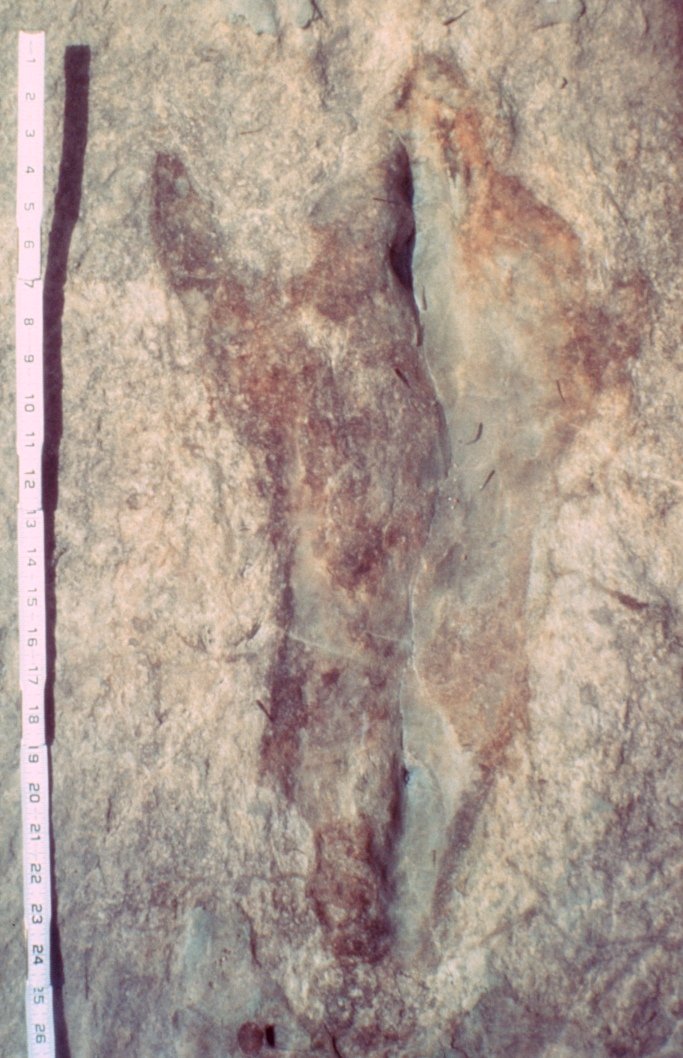 |
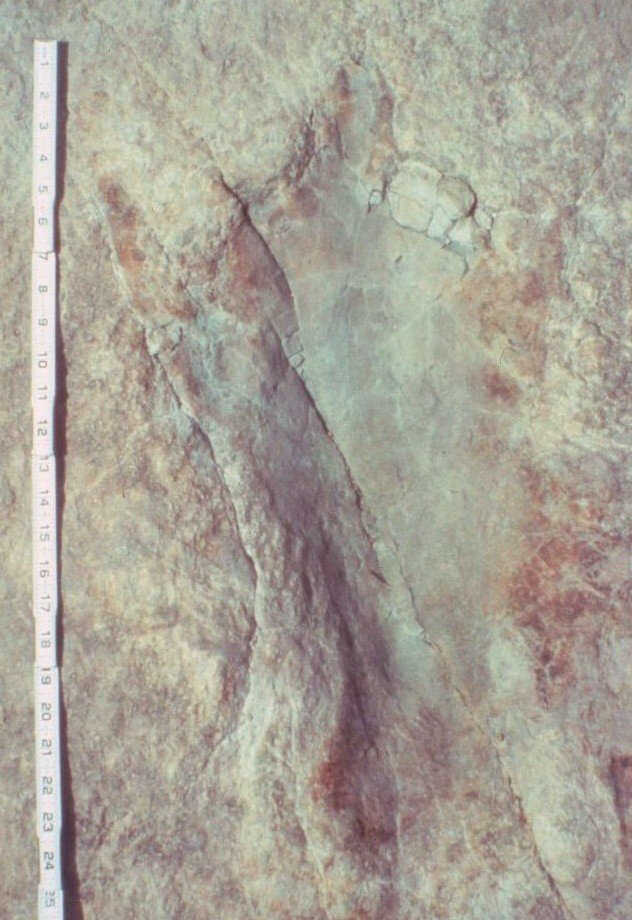 |
 |
| Figure 4. Taylor Trail tracks under shallow water, 1985. A. Track IIS,+4 (at left) showing more rust-brown color and thus more vivid contrast than in 1984 (compare to figure 1). | Figure 4B. Track IIS,+2 showing rust-brown coloration at the highest parts of the track (the sides and digits) and blue-grey coloration in the deeper middle region. | Figure 4. C. Track IIS,+3 (a right). The rounded front of the track is evidently due to the way the mud was pushed up by the "ball" of the dinosaur's foot, and/or a wide pad at the base of the middle digit. |
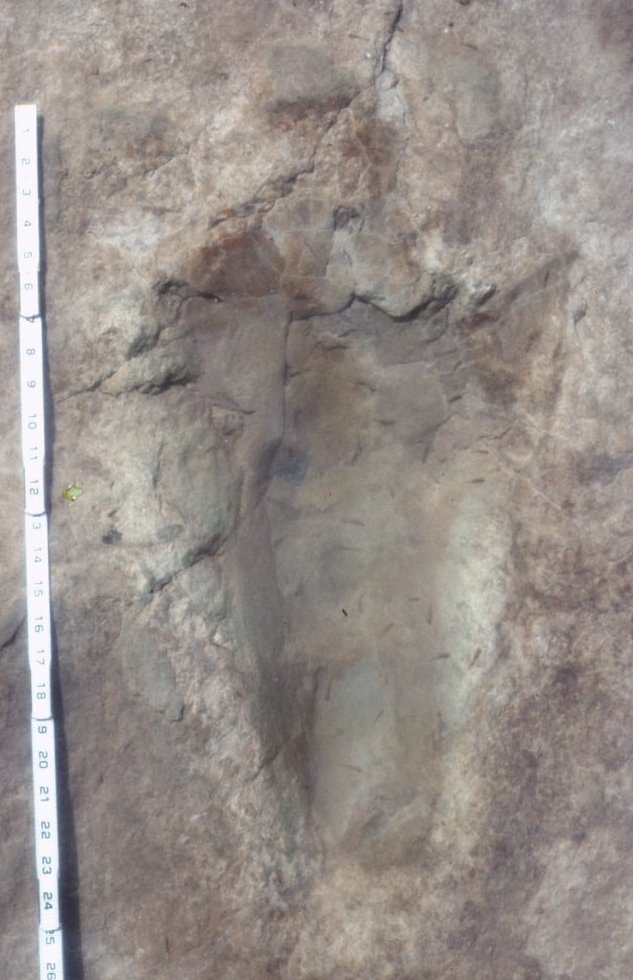 |
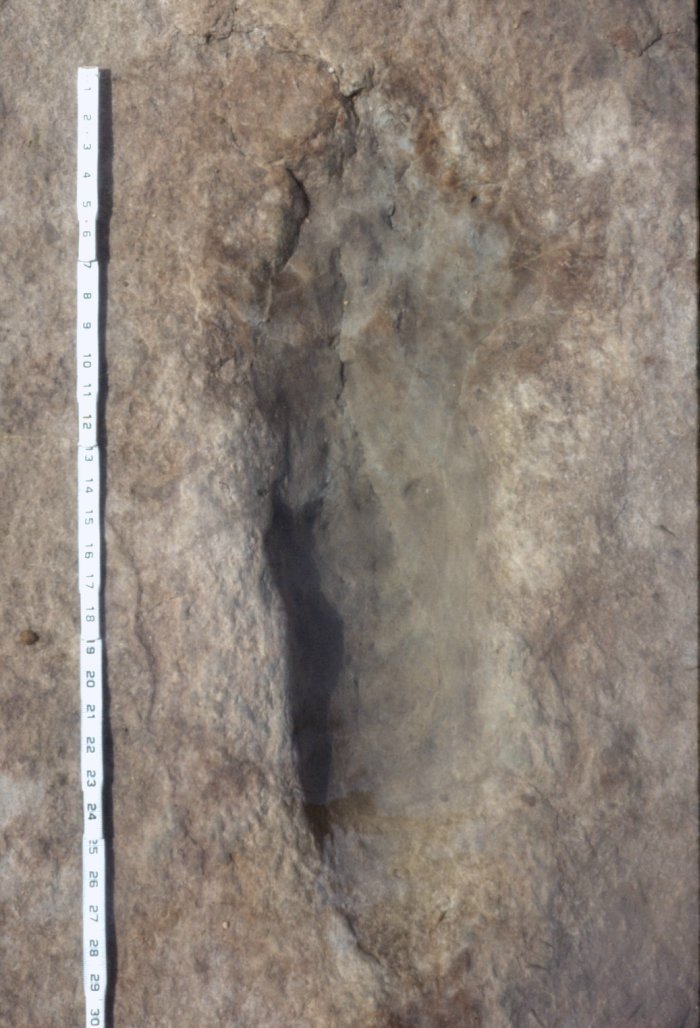 |
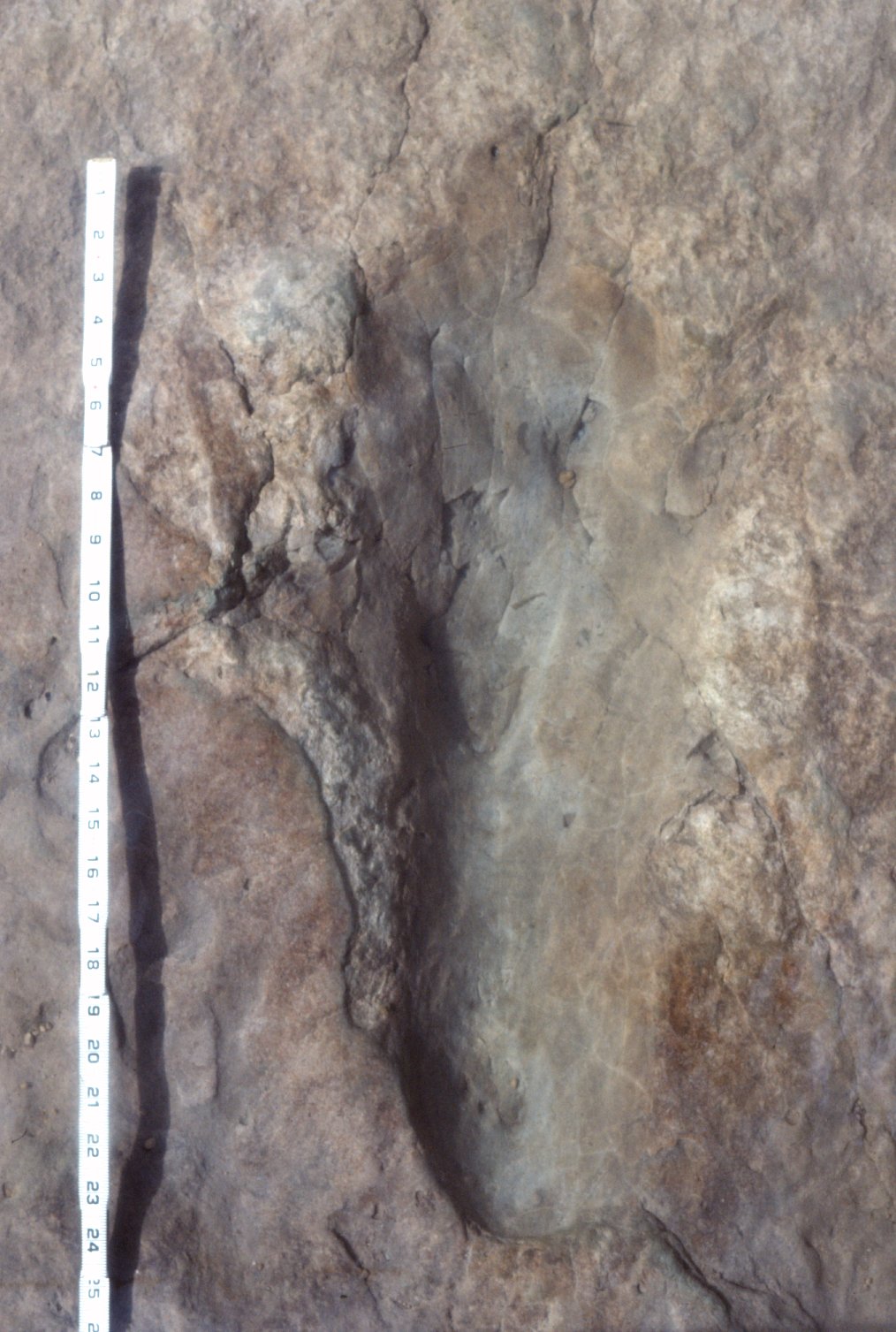 |
| Figure 4D. Track IIS,-1. | Figure 4E. Track IIS,-2. | Figure 4F. Track IIS,-3. |
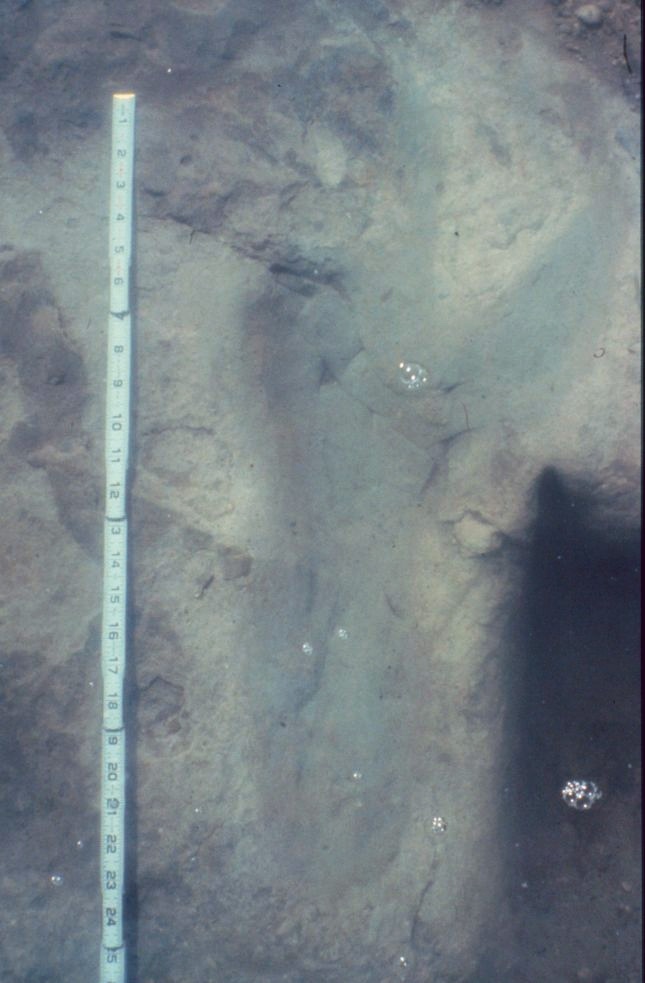 |
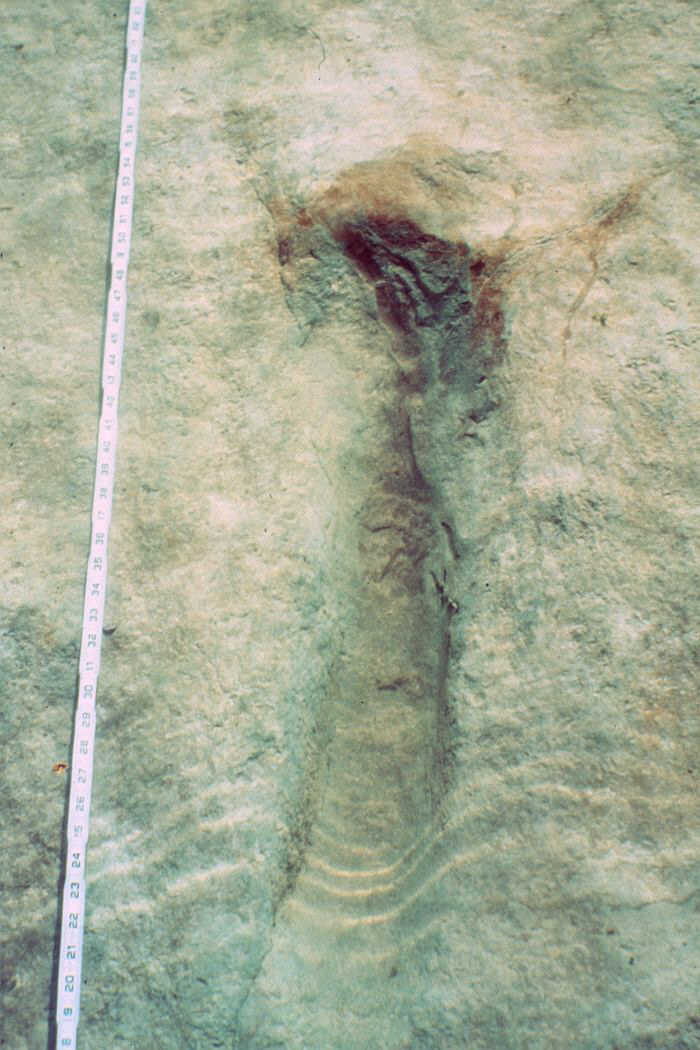 |
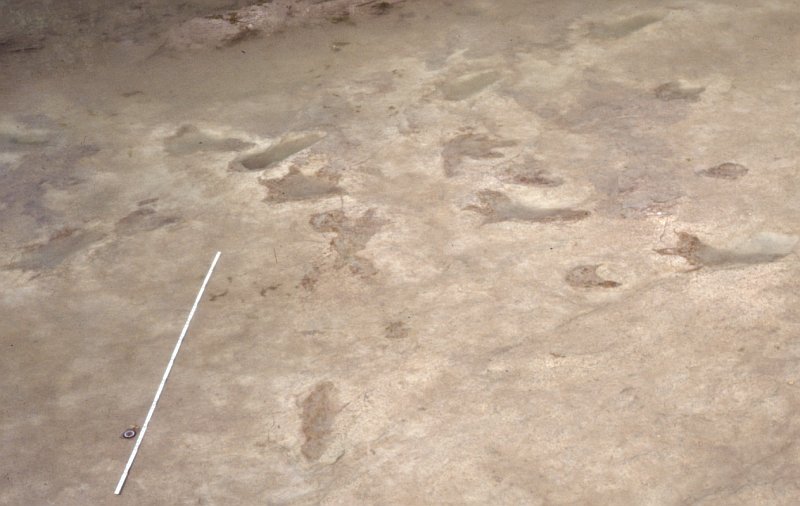 |
| Figure 4g. Taylor Trail, track IIS,-4, under shallow water, showing blue-grey coloration, next to deep dinosaur track IID7 (lower right). | Figure 5A. Ryals Trail track RY+4 under shallow water, 1985. Note tridactyl pattern at front of track. | Figure 5A. Middle section of Taylor Site, under shallow water, facing north, 1985. Track GR,-2 in foreground. Taylor trail proceeds from upper right to center left. Track IID+2 at far right. Photo by (c) 1985 Glen Kuban. |
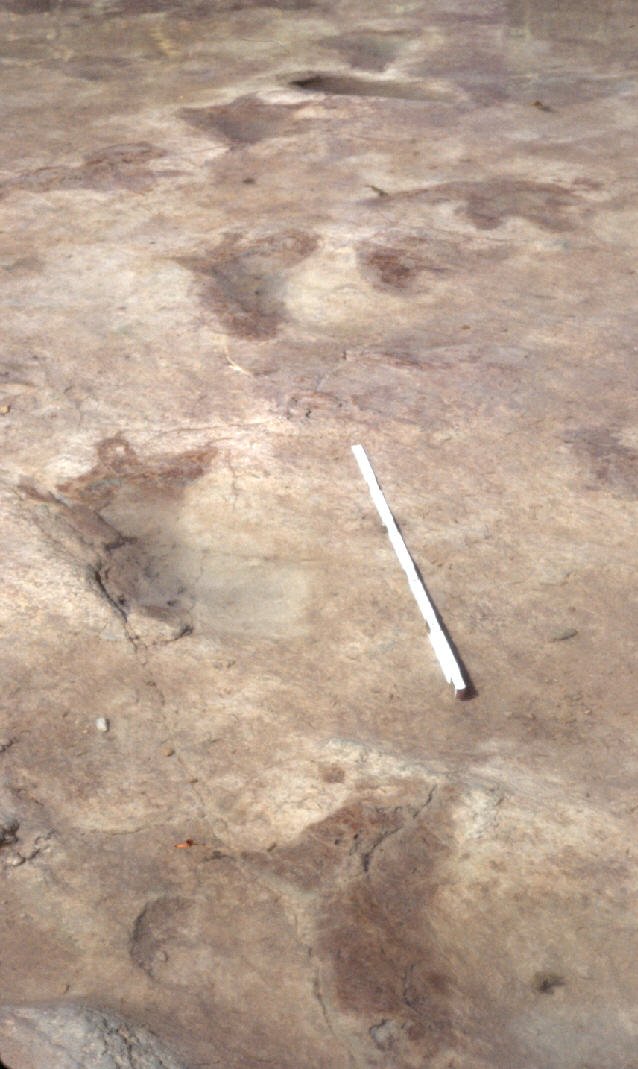 |
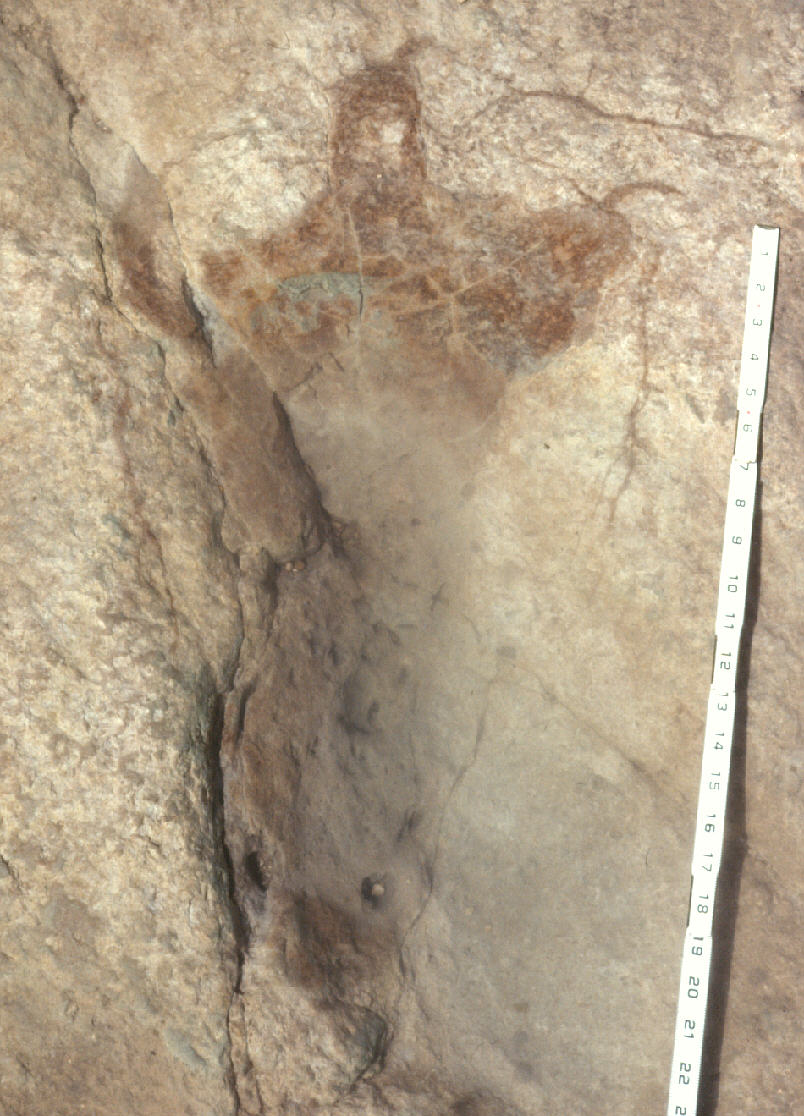 |
| Taylor Site, Trail IIDW, facing northwest (under shallow water), 1985. This trail extends across the entire width of the riverbed. Track IIDW1 at bottom. | Taylor Site, Track IIDW2, a largely infilled, full metatarsal dinosaur track, under shallow water, 1985. Note distinct coloration/infilling contrast and sharp claw marks. |
These colorations provide clear, corroborating evidence that all the tracks on the Taylor Site are dinosaurian. However, even before these colorations became more prominent, there was no reason to identify the tracks as human. There is much evidence the anterior splaying and other non-human features were quite visible on many of these tracks even when they were first uncovered. Besides being reported by the Loma Linda team, Booth, and others, these features can be seen even in Taylor's film: if one watches carefully, the anterior splaying can be seen on some of the Taylor Trail tracks in the distant shots showing the upriver end of the site. Ironically, Morris argues on page 97 of his book that the Taylor Trail tracks showed no evidence of dinosaurian origin, yet photos of these tracks on pages 204 and 205 of his own book show examples of anterior splaying and other problematic features (such as anterior groves in positions inconsistent with a human foot).
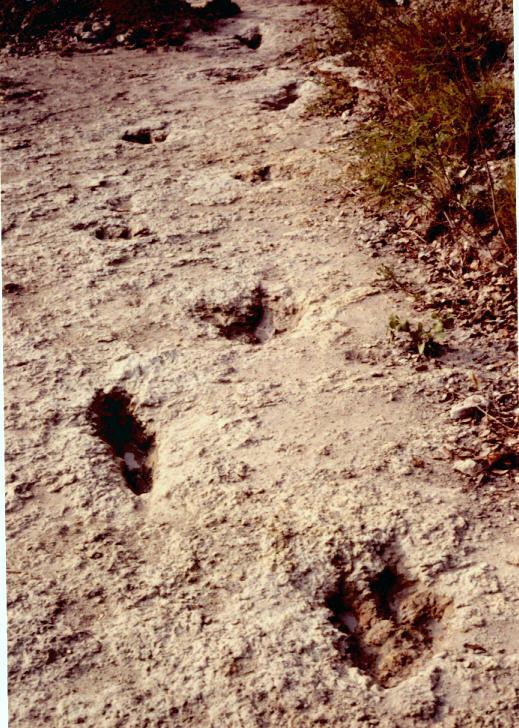
|
| Figure 6A |
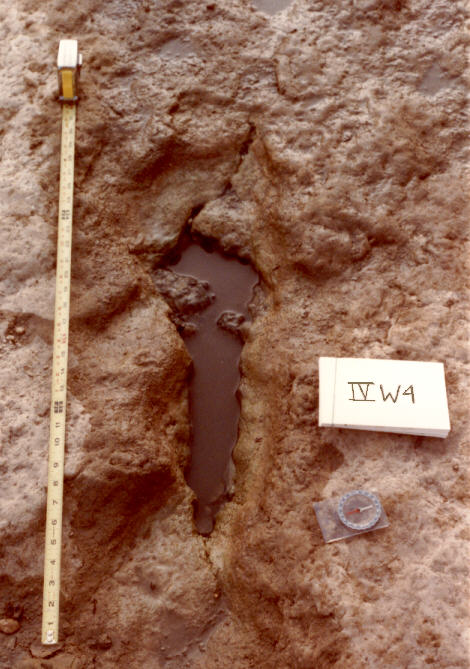
|
| Figure 6B |
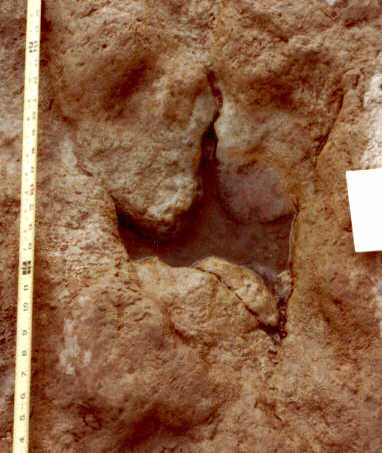
|
| Figure 6C |
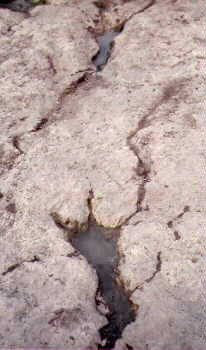
|
| Figure 6D |
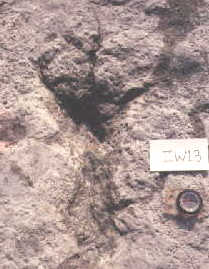
|
| Figure 6E |
Curiously, although Morris and Taylor both stated that 23 tracks were counted in the Taylor Trail at the time of the filming, there is no evidence that more than 10 or 11 tracks were seen in this trail at that time.[12] Even more curiously, only three of the Taylor Trail tracks were shown close up in the film: +4, +3, and +1. Track +4 did not look even remotely human; track +3 had an oblong shape, but showed no human toe impressions. Track +1 appears to have been incompletely cleaned, and was wet- out to look like a left human print, whereas it is really a right dinosaur print. The tracks at the downriver end of the Taylor Trail (east of +1) were not shown in the film at all; Morris and Taylor maintain that they were not seen at the time the movie was filmed. This is plausible, assuming that a secondary veneer of limestone covered the downriver portion of the site at that time. But this only compounds the problem of accounting for the reported 23 tracks in the trail. Even counting the downriver tracks, the Taylor Trail only includes 15 definite tracks (-7 through +6, as shown on my Taylor Site map). Morris reported that, when first exposed, the Turnage trail was thought to connect to the Taylor Trail at track +2, but this entails other problems [14], and does not account for a total even close to 23. Numerous other discrepancies occur in the film, Morris' book, and other works promoting the "man track" claims.[15]
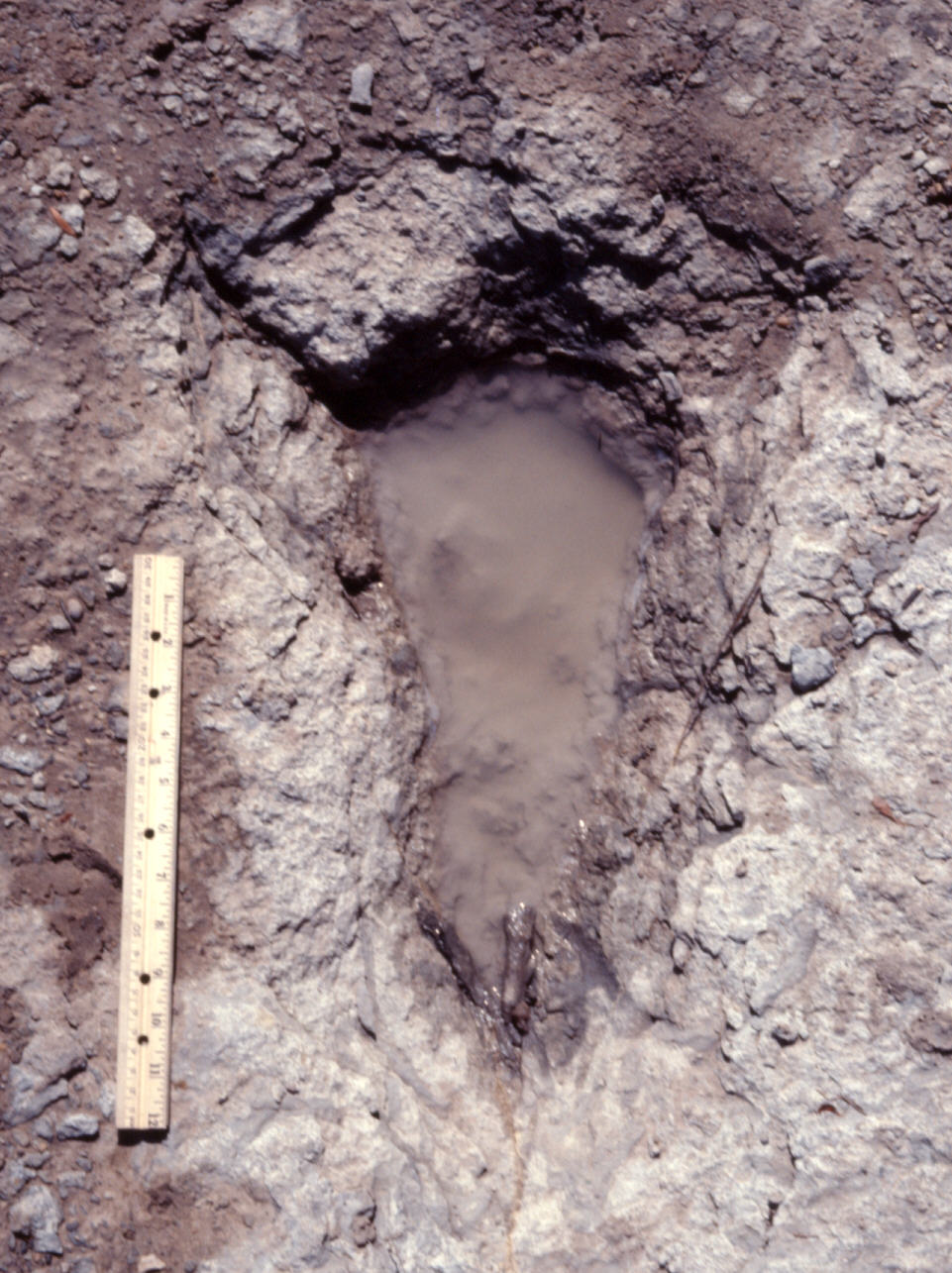 |
| Robust elongate dinosaur track on the western part of the Baugh-McFall Ledge, where the track surface is rough and incoherent. Note the oblong shape and indications of tridactyl digit pattern at the front of the track. Other tracks in this trail were less elongate and showed more prominent tridactyl indentations. This trail was not claimed to be human, but similar trails further west of the McFall Ledge were identified as human by some creationists. Photo by Glen Kuban, 1985. |
Besides the metatarsal impression phenomena on the Taylor Site, I have found that alleged "man tracks" on other sites have involved other phenomena, including natural irregularities of the rock surface; severely eroded specimens of typical tridactyl tracks; partial metatarsal impressions (interpreted by Carl Baugh, a recent "man track" promoter, as human tracks overlapping dinosaur tracks); indistinct oblong marks associated with dinosaur trails (apparently indicating a drag or swish mark of the dinosaur's tail, snout, or digit); and outright contrivances. After over five years of intensive research on this issue, I have concluded that no genuine human tracks have ever been found in the Paluxy Riverbed.
Afterword
Since the above article was published in early 1986 most creationists have largely abandoned the "man track" claims regarding the Taylor Site and most other Paluxy sites. However, in 1987 Carl Baugh and Don Patton began making claims that the Taylor Tracks were dinosaur tracks with human tracks within them. Such claims have been found to be as unsupported by the evidence as the original "man track" claims, and are reviewed in my article 'Retracking Those Incredible Man Tracks.'
[1] Burdick, Clifford C., "When Giants Roamed the Earth," Signs of the Times, July 25, 1950. Burdick's claims relied heavily on misrepresented statements of Roland Bird, a professional paleontologist who reported seeing some elongated depressions in the Paluxy, and the loose rock slabs shown by Burdick, but no genuine human tracks. These rock slabs are now acknowledged by most creationists to be carvings. [For a detailed analysis of one of these slabs, see the article The Burdick Print ].
[2] Henry M. Morris and John C. Whitcomb, 1961, The Genesis Flood Baker Book House: Grand Rapids, MI, pp. 173-175.
[3] Taylor, Stanley E., 1973, Footprints in Stone (film), Films for Christ Association, Mesa, AZ.
[4] John Morris states on page 96 of his book (reference 8), "the Films for Christ team noted that these prints were made by bare feet, showing clear toe marks in several of the tracks." Other claims of human toe impressions are made on pages 30-33, 60, and 203 of Morris' book, in Taylor's film (reference 3), and in other creationist works (for examples, see Beierle (reference 7), pages 3, 20, and 45). Despite these claims, there is no evidence that conclusive human features existed in any of the tracks. In Taylor's film, much ado was made over a small hole at the front of Ryals track RY+2. Taylor identified this as a human "big toe," even though there was no indication of other human toes. He held a "what else could it be?" position, without considering the possibility that it could be a spurious mark or the remains of a mud-collapsed dinosaur digit (which it now appears to be). The film also shows a cast of one of the Giant Run tracks alleged to show toe markings, however, the cast appears to have been selectively highlighted with pink pigment to encourage the appearance of human toes; I have never seen such features in the actual rock, or even in photos of this track.
[5] Neufeld, Berney, 1975, "Dinosaur Tracks and Giant Men", Origins, Vol. 2, No. 2, pp. 64-76. Most of the field work by this team was done in the summer of 1970.
[6] Rusch, Wilbert H., Sr., 1971, "Human Footprints in Rock," Creation Research Society Quarterly, Vol. 7, No. 4, pp. 201-213. In this article Rusch stated, "among creationist groups there is often considerable misplaced enthusiasm on the [man track] subject, with too great a willingness to jump to unjustified conclusions." Although his article focused on "man track" claims in locations other than the Paluxy, Rusch stated he would investigate the Paluxy claims, and make another report "should the results prove fruitful." He made no subsequent report. In 1981 Rusch related to me over the phone that he had visited the Paluxy sites in 1970 and 1971, and found "no definitive evidence" of human tracks. Ernest Booth (now deceased) investigated the Paluxy sites in 1970. Although Booth did not publish his findings, he related to me through letters and phone conversations that he agreed that the Taylor Site tracks were dinosaurian, and had found that the alleged human tracks on other sites were related to spurious phenomena. In a letter to me (dated November 29, 1981) Booth wrote, "Creationists have lost a lot of credibility over these so-called human tracks in the Paluxy... they are not human tracks at all...and many of them are not even tracks of any kind...We don't need this kind of evidence to support creation...."
[7] Beierle, Fred, 1977, Man, Dinosaurs, and History, Prosser, WA: Perfect Printing Co.; and Fields, Wilbur, 1980, "Paluxy River Exploration," Revised Edition (1977-1979), Joplin, MO., privately printed by Wilbur Fields.
[8] Morris, John D., 1980, Tracking Those Incredible Dinosaurs ...and the People Who Knew Them, San Diego: Creation-Life Publishers.
[9] Most Paluxy sites are under water except during the driest periods (usually between August and October). Even during dry periods, only the higher parts of the Taylor Site are typically dry; some years the entire site remains under water. In 1980 most of the site was dry, although sand dikes were needed to hold back water from the lower areas. We were not able to study the Turnage trail at that time (except IIN1) since we needed to place a sand dike over that area. I and others did expose Turnage tracks IIN2, II3, and IIN4, in 1984 and 1985, and found that these tracks showed clear dinosaurian features.
[11] Indications of these coloration distinctions can be seen in Footprints in Stone on Taylor Trail track +4 (which is shown at the point that the narrator states "some proved to be merely elongated slides...") and on the Ryals track RY+2. Photos taken by the Loma Linda team in 1970 show indications of the colorations on several of the Taylor Trail tracks.
[12] Paul Taylor gave me copies of four original field sketches by his father, Stan Taylor. One of these, dated 1969, shows 7 tracks in the Taylor Trail, another dated "1969 or 1970" shows 10 tracks, but does not show a separate Turnage Trail; a third map, dated "1969 or 1970 (?)" shows 10 ovals, apparently drawn to represent the Taylor Trail, but notations off to the side indicate 11 and 5 (apparently for the Taylor and Turnage Trails respectively).
[13] Elongated dinosaur tracks have been reported on sites in Connecticut, New Jersey, Brazil, China, Australia, and other locations. These are discussed further in my monograph (reference 16).
[14] Morris states on page 207 of his book that Taylor counted 23 tracks through track +21, yet Morris only shows tracks +6 through -7 in his photos and map of the site (and does not even count -7 as a track, but a "probe hole"). At the recent Paluxy meetings Morris admitted that he never saw the supposed tracks between +6 and +21, nor did he have evidence that Taylor or anyone else ever saw them. Indeed, in 1984 Hastings and I had exposed the site to a distance of about 4 meters west of track +6, and found no clear tracks that appeared to be related to the Taylor Trail. Two small depressions occur a short distance to the west of track +6, but these are shallow and irregular, and their connection to the Taylor Trail is uncertain. Beyond this was a depressed area without any tracks or significant depressions. Since Morris now admits that no definite tracks in this trail were seen west of +6, and maintains that Taylor's did not see any tracks east of -2, that leaves a total of 8 tracks in this trail originally seen by the film crew--quite a difference from the original claim of 23. Even allowing the dubious mistake about the connection to the Turnage Trail (discussed under reference 15), the total still amounts to no more than 15 tracks.
[15] Since there is a gap of over 21 feet (over 6 meters) between Taylor trail track +2 and the nearest Turnage track, the track- maker would need to be a professional long jumper for this to be considered a "connection." When I pointed this out to Morris at the site in October, he initially defended his original statement, but later decided the presumed connection must have been at Taylor Track -1 or -2. Even these tracks do not make a close or smooth connection with the Turnage Trail. Furthermore, Turnage's own field map from October of 1971 shows the Turnage and Taylor trails marked with separate numbering systems, indicating that Turnage himself considered these separate trails. This issue and related questions about tracks -3B through -7 and discussed further in my monograph (reference 18).
[16] For example, on page 96 of his book (reference 8), Morris shows a photo of track +1, showing it essentially as it appears today--a very elongated track with a rough hole at the front (apparently the result of overlapping tracks, since +1 now known to be at the intersection of at least three trails). He even points out that it is "over four inches deep" (even though it is only the anterior hole that is four inches deep). But a photo on page 208 shows this same track as a small, shallow depression (apparently incompletely cleaned-out, with the front of the actual track extending beyond the left border of the photo), and wetted-out to look like a left human footprint, whereas it is really a right print (and is actually a dinosaur track). Further, the chart on page 206 states that the "heel" of this track is four inches deep, contradicting the photo on page 208, and the fact that the deep part of the track occurs at the front, not the heel. Other discrepancies in the literature are discussed in my monograph (reference 18).
[17] Morris, John D., 1986, "The Paluxy River Mystery", Acts- Facts-Impacts, Vol. 15, No. 1.
[18] Kuban, Glen J., 1986, The Texas "Man Track" Controversy, self-published monograph, P.O. Box 33232, N. Royalton, OH 44133. 2003 Note: The above address is no longer valid. Glen Kuban now resides in Tomball, Texas.